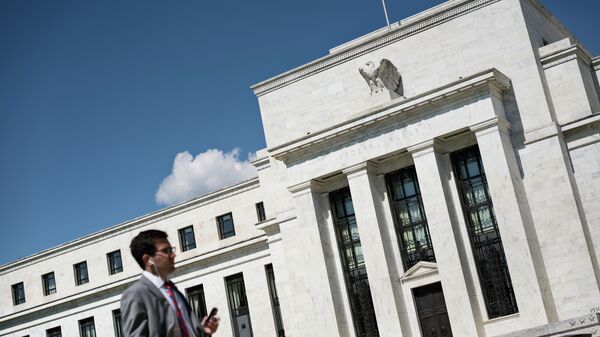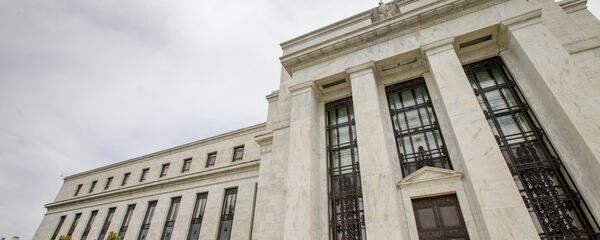Kristian Rouz — The US Federal Reserve has been gradually reducing its bloated balance sheet for several months now, with its total holdings of assets having dropped from some $4.5 trillion in late 2015 to roughly $4.37 trillion this year. However, the gains in benchmark US overnight borrowing costs might thwart this Fed effort.
Earlier this month, the Fed hiked its base borrowing costs by 0.25 percent to 2.00 percent and raised its interest rate on excess reserves from 1.93 percent to 1.95 percent.
READ MORE: US Federal Reserve Might Adjust Obscure Interest Rate for Second Time
However, borrowing costs on the open market rose to 1.92 percent — just 3 basis points below the Fed's IOER and 8 basis points below the upper threshold of the base borrowing costs range, set at 1.75-2.00.
"Here we are, and I think they will be lucky to get one more done this year, because whenever the curve flattens the market's going to look at the Fed and say, 'Really?' and the Fed will have to blink," Christopher Whalen of Whalen Global Advisors said. "They're telling everyone there's going to be a couple more rate increases, and that's fanciful."
The Fed is supplying the open market economy with money liquidity, and its policies of raising interest rates and reducing the balance sheet (by selling its holding of US Treasuries, for example) have reduced the volume of funds available for commercial banks.
Meanwhile, the Fed's reduction of bond holdings — which commenced last October — has also made it dearer for commercial banks to borrow excess reserves money to meet regulatory requirements.
Now, how are the Fed's bond holdings connected to the costs of credit in the market? By selling holdings of Treasury bonds, the Fed dampens the face value of a Treasury note, and a lower value means a higher yield on the bond.
READ MORE: US Federal Reserve Keeps Interest Rates Unchanged at 1.5 — 1.75 Range
For their part, yields on benchmark US Treasury notes are a key measure for open market participants — if the US government is borrowing money at a certain rate, they think, it would be safer for us to borrow and lend at that same rate.
If the Fed continues selling its Treasury holdings, open market interest rate will rise even closer to two percent, and could also surpass the Fed's IOER — meaning the Fed would have to hike its interest rates sooner in order to maintain control over the market.
However, macroeconomic indicators might not support a more aggressive path of Fed rate hikes — if US inflation drops below two percent, or unemployment starts increasing, or GDP growth rate slows, the central bank will have to temporarily halt its interest rate hikes.
The central bank would also have to halt its reductions of the bond portfolio — due to the threat of rising bond yields and open market interest rates.
"It's a signal that perhaps they are closer to their balance sheet bottom than they had previously thought," Steven Blitz of New York-based TS Lombard said.
This Fed dilemma has, however, a possible solution. If the US economy continues its steady acceleration, and inflation is persistently overshooting the 2-percent target — which isn't that hard to imagine in the face of global trade woes — the Fed will be able to keep hiking its interest rates, whilst selling its Treasury holdings at a pace appropriate for open market participants.
However, if the US economy slows, and inflation drops below two percent again, the Fed will have to halt or reverse its policy course. This is unless the Trump administration undertakes additional pro-growth measures, such as a second round of tax cuts, or a massive deregulation package.
Currently, the overall volume of excess reserves in the US economy stands at $1.9 trillion and is expected to decline to $1.7 trillion by December, and further down to $1.2 trillion by late 2019. This is due to the rising commercial bank demand for reserve liquidity as banks are seeking to support their capitalization and be in compliance with federal rules.
The Trump administration could also cut banking sector regulations, whilst the Fed could cut its reserve requirements to stave off market demand for reserve liquidity, which could be part of a broader solution.
The Fed recently sought to discourage banks from borrowing reserve liquidity in the market and capitalizing on parking this money at the central bank at a higher rate. This comes as the Fed is seeking to encourage bank lending rather than speculation on the difference in reserve rates.
READ MORE: Need to Revive Regional Trade Agreements to Counter US Trade Policy: Economist
Meanwhile, the US reserve capital market is severely monopolized, with 90 percent of excess reserves held by the top 5 percent of the country's largest banks, according to data from Morgan Stanley.
This situation poses a complex multi-dimensional regulatory and policy challenge to both the Fed and the White House, and officials are currently seeking a broader solution to this excess reserves conundrum.





